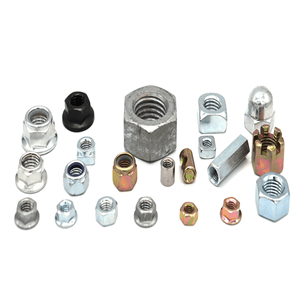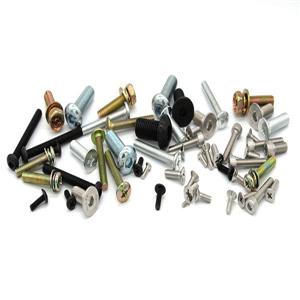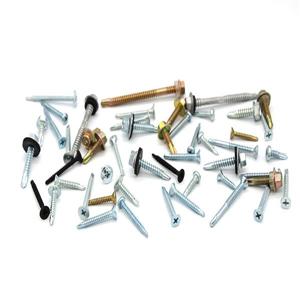Summary of glossary of metal materials and heat treatment
1
Heat treatment
In production, the operation of heating, holding, and cooling the steel to cause a solid phase transformation to change its internal structure and thereby improve the mechanical properties is called heat treatment.
2
Normalizing
Heat the workpiece to Ac3 (Ac refers to the final temperature at which all free ferrite is transformed into austenite during heating, generally from 727 ℃ to 912 ℃) or Acm (Acm is the complete eutectic steel in actual heating. The critical temperature line for austenitization is above 30 ~ 50 ℃. After holding for a period of time, the metal heat treatment process is taken out of the furnace in the air or sprayed with water, spray or air.
3
Quenched
Heat the steel to a certain temperature above Ac3 or Ac1, hold it for a certain period of time, and then take it out for water or oil cooling to obtain martensite heat treatment process.
4
Isothermal quenching
The austenitized workpiece is quenched into a molten salt with a temperature slightly higher than Ms, and is maintained isothermally for a sufficient time to cause the bainite transformation of the supercooled austenite at a constant temperature. After the transformation is completed, the treatment method is taken out and cooled in air. For isothermal quenching.
5
Step hardening
The austenitized workpiece is quenched into the molten salt whose temperature is slightly higher or lower than Ms. After the temperature inside and outside of the workpiece is uniform, it is taken out from the molten salt and cooled to room temperature in the air to obtain a martensite structure. This treatment is called step hardening.
6
Single liquid quenching
The austenitized workpiece is placed in a quenching medium until the transformation is complete.
7
Two-liquid quenching
The austenitized workpiece is first placed in a cooling medium with a strong cooling capacity for a certain period of time. After cooling to a temperature slightly higher than Ms, the workpiece is immediately taken out and placed in another cooling medium with a slower cooling capacity, so that It is transformed into a heat treatment process of martensite.
8
Tempering
A heat treatment process in which the quenched steel is heated to a temperature below the critical point A1, held for a certain period of time, and then cooled to room temperature.
9
Tempered sorbite
When the quenched and tempered carbon steel is tempered at 500 ~ 650 ℃, a multiphase structure composed of coarse grain cementite and polygonal ferrite is obtained.
10
Tempered bainite
When quenched and tempered at 350 ~ 500 ° C, a multiphase structure composed of fine granular cementite and acicular ferrite is obtained.
11
Tempered martensite
When the quenched and tempered carbon steel is tempered below 250 ° C, a multiphase structure composed of a supersaturated α solid solution and a dispersedly distributed carbide is obtained.
12
annealing
It is a heat treatment process that heats the steel to a temperature above or below the critical point and cools it with the furnace after holding for a certain period of time. It is the most widely used and most diverse type of heat treatment process. Different types of annealing have different purposes.
13
Isothermal annealing
A heat treatment process in which a hypoeutectoid steel workpiece is heated to 20 ~ 30 ° C above A3, held for a certain period of time, and then isothermalized at a temperature in the pearlite transformation interval below Arl to convert it to pearlite, and then air-cooled out of the oven. It can effectively shorten the annealing time, improve production efficiency, and obtain uniform structure and properties.
14
Fully annealed
The heat treatment process of heating the eutectic steel's casting, forging, welding parts and hot-rolled profiles to A3 above 20 ~ 30 ° C, holding it for a certain period of time, and then cooling to 500 ~ 600 ° C with the furnace. The purpose is to refine grains, reduce hardness, improve cutting performance and eliminate internal stress.
15
Spheroidizing annealing
The workpiece of the hypereutectoid steel or alloy tool steel is heated to 20 ~ 30 ° C above the Ad, held for a certain period of time, and then cooled with the furnace to about 500 ° C, air-cooled (common spheroidizing annealing) or cooled to 20 ° C below Arl. After a certain period of isothermal time, it is cooled to about 500 ° C and then air-cooled (isothermal spheroidizing annealing) to obtain granular pearlite. The purpose is to reduce the hardness, uniform structure, improve cutting performance, and prepare the structure for quenching.
16
Diffusion annealing
For important or alloy steel ingots or castings containing non-uniform chemical components such as dendrite segregation, in order to achieve uniform chemical composition, it can be heated to a core of 3 or more at 150 ~ 300 ° C, followed by a furnace after long-term heat preservation An annealing process for slow cooling. Because diffusion annealing requires long-term heating at high temperature, the austenite grains are very coarse. To this end, a complete annealing or normalizing must be performed to refine the grains to eliminate overheating defects.
17
Recrystallization annealing
The metal after cold deformation is heated above the recrystallization temperature and maintained for an appropriate time to transform the deformed grains into uniform equiaxed particles. This heat treatment process is called recrystallization annealing.
18
Stress relief annealing
In order to eliminate the residual internal stress caused by deformation processing and casting and welding, in order to improve the dimensional stability of the workpiece and prevent deformation and cracking, the workpiece is slowly heated with the furnace to 500 ~ 600 ° C. The furnace is slowly cooled down to 300 ~ 200 ° C.
19
Surface heat treatment of steel
A type of heat treatment method that makes the surface of the part very hard and wear-resistant, while the core still maintains its original good toughness and plasticity.
20
carburization
Carburizing is the infiltration of carbon atoms into the surface layer of the workpiece to increase the carbon content of the surface layer, which is generally 1 = 0. 8% ~ 1.05%. High abrasion resistance, and the center has sufficient strength and initial degree to achieve the purpose of hard outer and inner.
twenty one
Nitriding
It is a process of infiltrating nitrogen into the surface of steel parts. The purpose of nitriding is to increase the hardness and wear resistance of the surface of the steel, and increase the fatigue strength and corrosion resistance.
twenty two
Thermal Spray
It is a technology that uses special equipment to heat and melt or soften a solid material and accelerate it to the surface of the workpiece to form a special thin layer to improve the corrosion resistance, wear resistance, and high temperature resistance of the machine.
twenty three
Physical vapor deposition (PVD method)
It is a vapor deposition method that uses physical methods to generate deposited atoms or ions, and no chemical reactions occur in the room.
twenty four
Chemical vapor deposition (CVD method)
It is a method of inputting thermal energy or radiant energy into a gas-phase reaction chamber filled with any pressure to cause a certain chemical reaction in the gas phase. As a result, a solid film is deposited on a specific surface of a workpiece.
25
Metal ion implantation
It is a treatment process in which high-energy beam ions are driven into the surface of a metal material to form an extremely thin near-surface alloy, thereby changing the physical, chemical and mechanical properties of the substrate surface.
26
Electroless plating
The process of placing a part in a plating bath filled with special chemical agents ^ After a certain period of time, due to the electrochemical reaction between the chemical agents, a process of obtaining a certain thickness of coating on the surface of the workpiece is called electroless plating.
27
Critical quenching diameter
It refers to the maximum hardenable diameter (that is, the maximum diameter of the core being half martensite) obtained when the round bar sample is fired in a medium, and it is expressed by D0.
28
Isothermal transition
Isothermal transformation refers to the rapid cooling of austenitized steel to a temperature below A1, so that the supercooled austenite undergoes structural transformation during the heat preservation process, and is cooled to room temperature after the transformation is completed.
29
Continuous cooling transition
That is, the austenitized steel is continuously cooled from high temperature to room temperature at a certain cooling rate. The structure transformation completed during continuous cooling is called continuous cooling transformation.
30
Martensite
It is a kind of organization name of ferrous metal materials, and it is a supersaturated solid solution of carbon in a-Fe.
31
Flaky Martensite (Needle Martensite)
It is a typical martensitic structure formed in medium and high carbon steels and high nickel iron-nickel alloys. The flake martensite has a convex lens shape. Because the grinding surface of the sample is cut off from it, it is needle-shaped or bamboo leaf-shaped under an optical microscope. Therefore, flake-shaped martensite is also called needle-shaped or bamboo leaf-shaped horse Martensite.
32
Lath martensite
It is a martensite formed by austenite with low carbon content. It is a typical martensite structure in low carbon steel, medium carbon steel, and stainless steel. Because the microstructure is composed of clusters of laths, it is called lath martensite.
33
Austenite stabilization
Within the martensite transformation temperature, if the cooling is stopped at a certain temperature, and the cooling is continued after a period of time, the martensite transformation does not start immediately, but the transformation restarts after a period of time, and causes residual The corresponding increase in the amount of austenite is called the stabilization of austenite. Because it is caused by constant temperature, it is called thermal stabilization.
34
Supercooled austenite
Austenite is cooled to below the critical temperature and is in a thermodynamically unstable state. Decomposition transformation occurs during cooling. This type of austenite, which exists and is unstable below the critical transition temperature, is called supercooled austenite.
35
Bainite
When the austenite is undercooled to a temperature region lower than the pearlite transformation temperature and higher than the martensite transformation temperature, a transformation that combines shear transformation with short-range diffusion occurs. The transformation product is called bainite or Bain body. That is, when the austenite of the eutectoid component stays isothermally within the temperature range from the "nose" to the ^ point, bainite transformation will occur, forming a non-lamellar structure-bainite composed of two phases, ferrite and carbide.
36
Hardenability of steel
The hardenability of steel refers to the ability of austenitized steel to obtain martensite during quenching, and its size can be expressed by the depth of the hardened layer obtained by quenching the steel under certain conditions. The deeper the hardened layer, the better the hardenability of the steel.
37
Hardenability of steel
Hardenability refers to the highest hardness that can be achieved by a martensitic structure formed at a rate exceeding the critical cooling rate under ideal quenching conditions. It is also called hardenability.
38
Actual grain size
The austenite grain size obtained under a specific heating condition is called the actual grain size. The actual grain size is different from the initial grain size. The initial grain size is the grain size when the austenite is just formed (that is, its grain boundary has just touched). After a certain period of heat preservation. The diameter of the actual grains is larger than the diameter of the starting grains.
39
Temper brittleness
Temper brittleness refers to the phenomenon that the toughness of the quenched steel decreases after tempering. When the tempered steel is tempered, with the increase of the tempering temperature, the hardness decreases and the toughness increases, but in the relationship curve between tempering temperature and impact toughness of many steels, two troughs appear, one at 200 ~ 400 ℃ Between, another between 450 ~ 650 ℃. With the increase of the tempering temperature, the impact toughness decreases, and the tempering brittleness can be divided into the first type of tempering brittleness and the second type of tempering brittleness.
40
High temperature tempering brittleness
The brittleness of quenched steel in the temperature range of 500 ~ 650 ℃ is called high temperature tempered brittleness, also known as the second type of tempered brittleness. This type of tempering brittleness mainly occurs in steels containing alloy elements such as Cr, Ni, Mn, and Si.
41
Low temperature tempering brittleness
The brittleness of the quenched steel in the temperature range of 250 ~ 400 ℃ is called low temperature tempered brittleness, also known as the first type of tempered brittleness. This brittleness occurs in almost all quenched steels when tempered at about 300 ° C.




